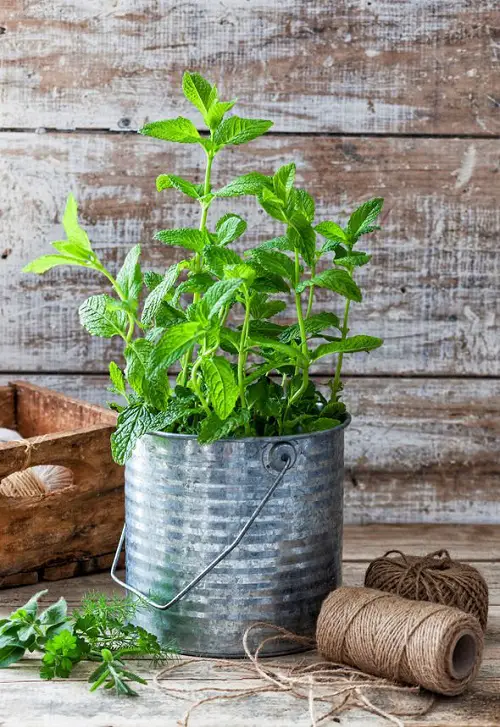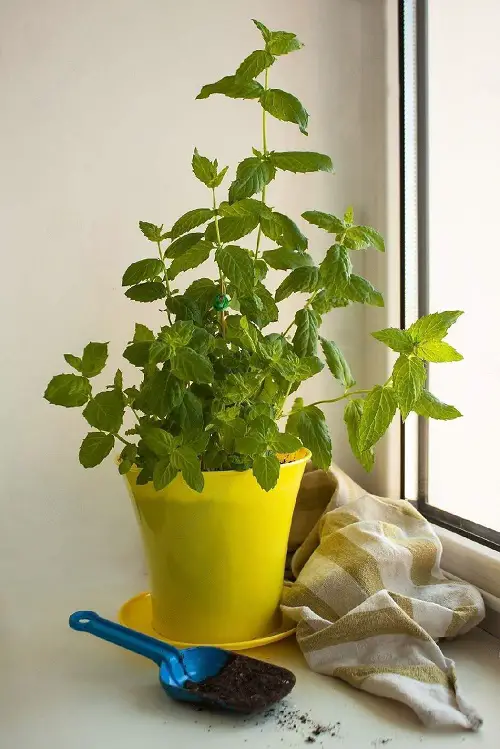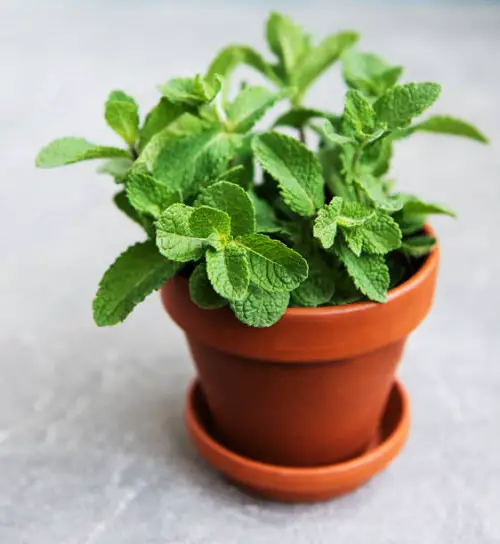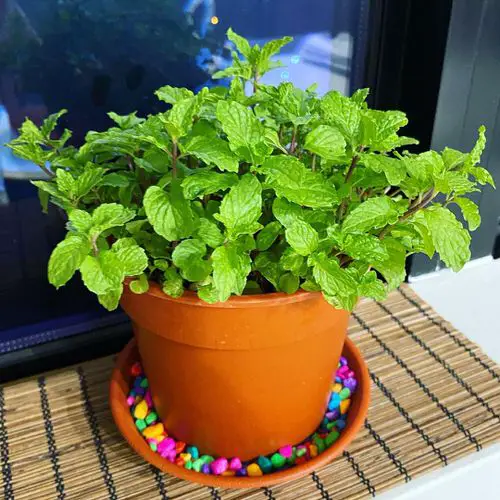Fragrant, fast-growing, and one of the most used culinary herbs – Growing Mint Indoors is easy and doesn’t require much effort!

Can you grow mint indoors? Of course, you can! Growing mint indoors is an easy job if you know what to do and how to do it. Lucky for you, here’s the best indoor mint growing guide.
Mint Plant Information and Why You Must Grow It
Mint, a widely cultivated herbaceous plant, belongs to the Lamiaceae family, which encompasses numerous aromatic herbs. With its vibrant green leaves and distinctively refreshing scent, mint is instantly recognizable.
Growing mint indoors means you can enjoy this delightful herb any time of the year. Forget the dried versions; there’s nothing quite like plucking a fresh leaf to garnish your dish or brew a soothing cup of tea.
Mint isn’t just about taste; its vibrant green leaves can brighten up any room. Plus, the soothing scent of fresh mint can fill your home, offering a natural and refreshing aroma that beats any air freshener.
From savory dishes to desserts, mint can enhance a wide variety of recipes. Imagine whipping up homemade mint chocolate chip ice cream or adding a zest to your favorite salad – the culinary possibilities are endless!
Propagating Mint: How to Grow Mint Indoors
Ways to Propagate Mint Indoors
- Seed Planting
- Water Propagation
- Soil Propagation
- Division
Don’t know how to grow mint indoors? You can do it without much effort if you grow it using mint cuttings. Just follow these steps.
- Prepare the Cuttings: Take healthy mint cuttings about 4-6 inches long, making sure to remove any leaves from the lower part.
- Rooting Medium: Fill a small container with water and place the mint cuttings in it. Leave them in a bright spot for a week or until you see tiny roots growing.
- Select a Pot: Choose a suitable indoor pot with drainage holes. Fill it with a well-draining potting mix.
- Plant the Cuttings: Gently plant the mint cuttings in the potting mix, burying the rooted part and leaving the upper leaves above the soil.
- Location and Light: Put the pot in a bright spot with indirect sunlight, like near a window. Mint likes light but not direct sun.
- Regular Watering: Keep the soil slightly moist, but avoid overwatering. Check the top inch of the soil before watering when growing mint indoors.
Over time, your mint cuttings should start growing new leaves and spreading. Take care of your mint plant, and soon, you’ll have a beautiful mint plant you can relish.
Advantages of Growing Mint from Cuttings:
- Faster Establishment: Propagating mint from cuttings accelerates the growth process, as you’re starting with the established plant material that has already been rooted. This means you’ll have a thriving mint plant more quickly compared to growing from seeds.
- Genetic Consistency: When you grow mint from cuttings, you’re essentially creating a clone of the original plant. This ensures that the new plant will retain the same characteristics, flavor, and aroma as the parent plant.
- Reliable Results: Unlike seeds, which can have varying germination rates, cuttings tend to have a high success rate when it comes to rooting and developing into healthy plants. This predictability can be reassuring for novice gardeners.
- Mature Growth: Mint cuttings often come from mature plants, which means they are more likely to produce abundant leaves and establish themselves rapidly. This can be particularly beneficial if you’re growing mint for culinary or aromatic purposes.
Choosing a Container for Mint Indoors

Size
- Seedling Stage: Opt for small individual pots with a diameter of 4-5 inches to provide ample space for initial root growth while preventing overcrowding.
- Juvenile Stage: Transition to slightly larger containers with a diameter of 4-6 inches to accommodate the developing root system and allow the plant to establish itself further.
- Mature Stage: For fully grown mint plants, select larger containers with a diameter of 8-12 inches to provide adequate space for the roots and to support the plant’s mature size and vigorous growth.
Ensure the chosen container has sufficient drainage holes at the bottom to prevent waterlogging and root rot. Adequate drainage promotes healthy root development and prevents excess moisture buildup, which mint is susceptible to.
Here are Plant Pot Sizes from Inches to Gallon
Growing Mint in Water

It is also possible to grow mint in water too if you are thinking about growing mint indoors. This way, it’ll also make a beautiful glass planter that you can set up in any space to spruce up the decor.
- Take healthy mint cuttings about 4-6 inches long. Remove leaves from the lower part of the cuttings.
- Place the cuttings in a glass or jar with enough water to submerge the nodes where the leaves were removed.
- Put the container in a bright, indirect sunlight location. Change the water every few days to prevent stagnation.
- After a week or when you see tiny roots, transfer the rooted cuttings to a pot with well-draining soil.
- Plant the cuttings in the soil, burying the rooted part and leaving the upper leaves above the soil.
- Water gently after planting and place in a bright spot with indirect sunlight.
After a few weeks, you’ll notice growth, and your mint plant will be ready!
How to Grow Mint in Small Space (Balcony, Porch, Rooftop, and Windowsill)
Requirements For Growing Mint Indoors

Sunlight
Mint thrives in bright, indirect sunlight. Provide it with as much sunlight as possible for optimal growth. Just avoid growing it in a shaded spot.
Soil
- Type: Choose a well-draining potting mix with good aeration when growing mint indoors. A mix of peat moss, perlite, and compost works well to ensure proper drainage and root health for your mint plant.
- Fertility: Use moderately fertile soil with balanced nutrient content. Avoid excessively rich soils, as they can lead to excessive leaf growth with reduced flavor. Regular feeding with a diluted, balanced fertilizer can enhance the mint’s growth and aroma.
Water
- Frequency: Water mint when the topsoil feels dry to the touch. Aim to keep the soil consistently moist but not waterlogged. Avoid letting the soil completely dry out between waterings, as mint prefers steady moisture.
- Method: Use the “soak and dry” method for watering. Thoroughly water the plant until water drains from the bottom of the pot, ensuring even moisture distribution. Empty the saucer beneath the pot to prevent water accumulation. Avoid overhead watering to prevent fungal issues; instead, water directly at the soil level to keep the leaves dry.
Temperature
Don’t worry much about temperature range while growing mint indoors, as the plant is not fussy about it. As long as it gets proper exposure to direct sunlight (4-5 hours) and indirect exposure to light all day long, it will be very happy to thrive.
- Ideal Range: 65-86°F (18-30°C)
- Why: This range supports healthy growth without being too hot, which can cause the plant to become leggy.
Humidity: Mint likes some humidity, so if you’re growing it in a particularly dry environment, you might consider using a humidity tray or room humidifier.
How to Care for Indoor Mint Plant
Fertilizer
A balanced liquid fertilizer with a ratio like 10-10-10 or 14-14-14, would be just fine. Apply it every 4-6 weeks during the growing season (spring and summer), after diluting it to 1/2 of its strength.
Mint doesn’t need heavy feeding, and over-fertilizing can lead to excessive growth and a decrease in the flavor’s intensity. Yellowing leaves, poor growth, or a build-up of fertilizer salts in the soil
Read about 27 Types of Mints You Should Grow At Least Once here
Pinching
Pinching involves gently removing the tips of young stems, which encourages branching and leads to a bushier growth habit. Regular pinching, especially during the early stages of growth, helps create a fuller and more compact plant.
Pruning is not required if you are regularly harvesting it for consumption.
Pests
- Aphids: Tiny insects that suck sap from mint leaves, causing distortion and stunting.
- Spider mites: Microscopic pests that spin webs and feed on mint, leading to yellowing leaves.
- Whiteflies: Small, flying insects that sap plant juices and leave behind a sticky residue.
- Mealybugs: Soft, cottony pests that cluster on mint, weakening the plant and secreting honeydew.
- Thrips: Tiny, slender insects that pierce mint leaves and spread diseases.
Diseases
- Mint rust: Fungal disease causing orange or rust-colored spots on leaves.
- Powdery mildew: Fungal growth appears as white powder on mint leaves, hindering growth.
- Downy mildew: Fungal infection causing yellowing, curling leaves, and fuzzy growth on the undersides.
- Fusarium wilt: Soil-borne fungus causing wilting, yellowing, and decline of mint plants.
- Verticillium wilt: Fungal disease leading to wilting, browning, and death of mint foliage.
Benefits of Growing Mint Indoors

Mint growing indoors offers several benefits, some of which are:
- Fresh Culinary Herbs: Enjoy a continuous supply of fresh mint leaves for cooking, beverages, and garnishes right at your fingertips.
- Aromatic Environment: Mint’s refreshing aroma permeates indoor spaces, providing a natural and pleasant scent.
- Easy Accessibility: Having mint indoors means you can conveniently harvest leaves without going outside, especially during unfavorable weather.
- Year-Round Cultivation: Indoor growing extends mint’s growing season, allowing you to enjoy it even in colder months.
- Controlled Conditions: Indoor environments let you manage factors like light, water, and humidity, optimizing the mint’s growth and flavor.
- Decorative Element: Mint’s vibrant green foliage adds a touch of natural beauty to your indoor décor.
- Health Benefits: Fresh mint leaves offer potential health advantages, such as aiding digestion and soothing headaches.
Learn Growing Mint in Water here
Growing Mint Indoors – FAQs
1. Can You Grow Mint Indoors?
Yes, mint can be successfully grown indoors in containers. It thrives in well-draining soil, bright indirect sunlight, and proper care.
2. Can Mint Grow Indoors Without Sunlight?
While mint prefers bright indirect sunlight, it can tolerate lower light conditions, but growth may be slower, and the flavor might not be as robust. Supplementing with grow lights can help compensate for inadequate sunlight.
3. Can I Grow Mint Indoors?
Absolutely! Mint is well-suited for indoor cultivation in containers. Ensure it receives the right amount of light, proper watering, and appropriate soil conditions.
4. How to Grow Mint From Seed Indoors?
You can easily grow mint from seed indoors. Just follow these steps:
- Fill a seed tray or small pots with a well-draining potting mix.
- Sow mint seeds on the surface, gently pressing them in.
- Mist the surface with water and cover the tray or pots with plastic wrap.
- Place the container in a warm, bright location or under a grow light.
- Once seedlings emerge, remove the plastic wrap and continue providing light and water.
- Transplant the seedlings into individual pots when they have developed a few true leaves.
- Maintain proper care with sunlight, watering, and fertilizer as the mint plants grow.



I have a grow tent in the kitchen that I use for herbs and some veggies like lettuce. I grow mint, basil, oregano, thyme, dill, and others. I leave the light on about 14 hours a day and get really great growth and almost no blooms.
I love mint for my tea many times. Got to try this. Thanks. :)
I want to grow indoors mint plant I try but I can’t please somebody can help me
live in desert- palm Springs area, and 9 months of the year too warm to put on shaded table out side == now have indoors and center of new growth leaves turning black– is about 50 day time now and 40 at night.. .. guess I might look into a growing light as growing cilantro is an issue too…
The best part of growing mint indoors is that it repels spiders and ants! (Plus it doesn’t overtake your house like it does your yard if you don’t keep after it!)